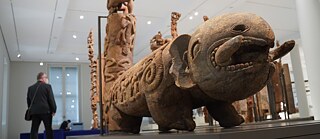A Conversation with Bénédicte Savoy Restitution is Like the Fall of the Berlin Wall

A drum from Cameroon in the shape of a fantasy creature is on display at the Humboldt Forum. Cultural artefacts from Africa, Asia, America and Oceania are on display at the Humboldt Forum. Bénédicte Savoy appeals to museums to be open about the history of such objects and how they ended up in museums. | Photo (detail): Jörg Carstensen © picture alliance / dpa
The renowned art historian Bénédicte Savoy is an expert on the forced appropriation of cultural assets through war and colonialism, an area of research that concerns everyone in Europe. This historical moment is an opportunity for museums and their visitors.
“Visitors today should enter the museum with their eyes wide open,” is Bénédicte Savoy’s valuable advice. Every time we visit a museum containing African art, we should ask ourselves, “What are these objects, how do they speak to us, what do they have to tell us?” It is not the same whether we are looking at a figure dating from the 16th century, which came here via pre-colonial trade, or a figure from the 19th century, the height of the colonial era. Among researchers, this is also known as World War Zero when, Savoy explains, multiple wars were waged and in each of them objects were forcibly looted from African countries and brought to Europe. The audience of a museum today should develop a historical awareness of what Europe is and what African countries have lost through the extraction of cultural objects.Transparency and Dismay at the Humboldt Forum
Bénédicte Savoy resigned from the expert advisory board of the Humboldt Forum because of disagreements. Now she has visited the newly opened museum in Berlin Mitte and was positively surprised by the transparency of the information. “For example, the explicit way that the objects are described in the Colony of Cameroon room is a novelty!” she says. “You learn that every item on display there came here as part of major, bloody military expeditions.” Finally, there is some transparency, but not just that, as it is accompanied by a sense of shock. Even the experienced art historian Bénédicte Savoy, with her many years of research on the looting of art, states “wide-eyed”: “I was horrified. Even I hadn’t realised the scale of it. I didn’t expect there to be blood on every single object on display.” The certainty of the violence seems so oppressive that it stands alone in the room. Everything else, as well as the actual museum experience, is lost. Savoy therefore demands:“It must not stop at these observations. Another step must be taken now!”
The Fall of the Wall is Here
“Once restitution begins, it will be like the fall of the Berlin Wall,” said then Minister of Culture of the Republic of Benin to Bénédicte Savoy and her colleague Felwine Sarr while they were there for France drafting the independent guide to the restitution of looted colonial property. He doubted that it would ever happen, while at the same time he was aware that it would involve a huge geopolitical shift in the museum system and cultural heritage. The first requests for restitution from African countries date back to the 1960s. For decades, European countries reacted with resistance and did not take a single step in that direction. As early as 1972, Nigeria demanded the Benin bronzes back from Germany. At the time, they only wanted the permanent loan of a few pieces, but even that was rejected at the time by those responsible at the Prussian Cultural Heritage Foundation in Berlin. Germany and other European countries were not prepared for the discussion.But now the time has come. In November 2021, after years of negotiations, the Republic of Benin became the first sub-Saharan African state to receive back substantial parts of its cultural heritage from a former colonial power. France returned 26 priceless objects to Benin. They are now on display in the city of Cotonou.
Germany has been negotiating intensely with Nigeria for just over a year and will return part of the Benin bronzes it has been demanding for 50 years.
It took more than half a century, but this wall has been breached and it is time for the rest of it to come down. Each country will do it on its own timetable, with its own taboos, its own difficulties, its own budget, but it will happen. There’s no turning back now. “I’m very confident. There’s no way around it!”
0 0 Comments